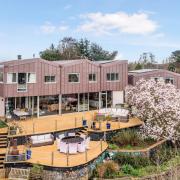Marion Welham visits Sotterley to learn more about the story behind this ancient Suffolk estate, the people who have called it home over the past 800 years, and the annual snowdrop display which raises funds to keep its history alive
Pushing through the gloom and slush of winter, spruce little snowdrops bring vitality and, best of all, the promise of spring. That’s why snowdrop walks are so popular at some of our historic Suffolk estates and gardens, and Sotterley is among them.
Few places paint a picture of the charm of hidden Suffolk as this enchanting 18th century estate with its mighty oaks and tiny paths winding through snowdrops, aconites and early narcissi as far as the eye can see.

The village of Sotterley is just a few miles from Southwold, but you could be forgiven for missing it altogether. The houses are dotted round the perimeter of the park and stand-out features are the banks of wild primroses, loved by walkers and cyclists in April, and a delightful jam stall raising money for the octagonal Gothic-style cemetery chapel on the corner.
The way local people diligently raise money for what they treasure in the landscape is a reminder of old rural Suffolk, and that’s what happens at Sotterley every February. Marion Lloyd, now in her 89th year, has been churchwarden of St Margaret of Antioch for over 20 years.
'I used to run the snowdrops and our annual fete, but I gave it up as we needed new blood,' she tells me, no more so than now as the church tower is starting to crack and needing £200,000 for its repair. St Margaret stands next to Sotterley Hall, an elegant Georgian mansion where Marion herself was brought up as a member of the Barne family, who have been at Sotterley since 1745. Not surprisingly, there are compelling stories to tell, of which more later.

Today Marion’s younger brother, Miles, and sister-in-law, Tessa, live in the hall with their family and continue to host visitors to the park for snowdrop walks each February, as well as to an annual open garden and fete in May in aid of the church. An annual country fair was launched in 2015, supporting several charities.
Marion points to the conundrum of which dates in February are best for showing snowdrops at their peak. She admits they were a tad late last year with some already going over, not that anyone would notice among the spectacular carpet of blooms. That said, Kew Gardens has been monitoring the common snowdrop Galanthus nivalis since the 1950s and reports they are flowering earlier, often in early January, which is an indication of our changing climate.

There are 20 species of snowdrop; the numerous hybrids found in Suffolk mainly come from the common snowdrop Galanthus nivalis, the greater snowdrop Galanthus elwesii, and Galanthus plicatus with its pleated leaves. But, unless you are a dedicated galanthophile, such detail won’t interfere with the sheer joy of strolling through whole carpets of these heroic little flowers. Much nicer simply to know that Galanthus nivalis is Greek for 'milk flower of the snow'.
The snowdrop walk through the 300-acre Sotterley park is a journey back to a more tranquil past – the faded gentility of the hall, the former riding school glimpsed through the trees, and the ornamental lake with its boathouse and Palladian folly. On snowdrop opening days, coffee and tea will be available, along with home-made cake in the 14th century church, when visitors will also have the chance to discover more about the remarkable history of this estate, now renowned for its green approach to farming and countryside.

Only three families have lived at the hall in almost 800 years, namely Soterley (or Satterley), Playters and Barne. An outstanding 17th century memorial to Thomas Playters in the church features an eye-popping 22 children from two wives, both called Anne. The Playters were given the manor by Edward IV after the Soterleys were involved in a rebellion during the Wars of the Roses. It was Marion’s ancestor Miles Barne, son of a London merchant, who took on the estate in 1745, rebuilding the 15th century home of the Playters family after a fire.
There are many gripping tales to discover about those three eminent Suffolk families, but perhaps one of the most intriguing was recorded by Marion’s late husband Richard Lloyd. He diligently researched how the Satterleys were among the early American settlers, with Henry Yates Satterley becoming Bishop of Washington DC, helping to set up the National Cathedral there. The Barne family also had connections with Suffolk’s Bartholomew Gosnold, who helped to found the Jamestown settlement over 400 years ago. Richard’s book, Welcome to Sotterley, and its important transatlantic connections marked the anniversary and will be on sale at the snowdrop event.

Two wooden crosses in the church are a poignant reminder of the early deaths in World War I of Marion’s grandfather, Miles Barne, of the Scots Guards, and his brother, her great uncle Seymour, of the Royal Flying Corp. With so many hundreds killed in France, these simple crosses marked their graves until more permanent memorials could be organised. A third brother, Royal Navy officer Michael Barne, was the last surviving member of the 1901-04 Discovery expedition to Antarctica led by Robert Falcon Scott.
'He was a great friend of Scott’s and Scott was very keen for him to go on the second expedition,' says Marion, 'but he had frostbite and eventually had to have his leg off because of that. He was down in the naval hospital at Portsmouth and all sorts of people came to see him. He was a very modest man. And then, of course, if he had gone on that expedition, history would have changed completely.'

Eight members of the Barne family, including Marion, went to Dundee to mark the anniversary of the Discovery in Dundee. 'It was so fascinating and I’m quite proud of that,' she says.
Marion says there have been snowdrops at Sotterley as long as she can remember, but during World War II the family moved to Surrey, then to Southwold when the army took over the house, as they did so many others in Suffolk.
'The house was all fumigated and cleaned after the army had left. I remember coming back and it was totally empty with no carpets, so we used to cycle round the house. Such fun!'

There are many more stories to discover about one of Suffolk’s most illustrious families which, for almost 200 years, also owned much of Dunwich, including parliamentary seats. Marion says she enjoys talking to visitors to the church on snowdrop days and for the open garden and fete, which is on May 6 this year. She rang the bells on the morning of the King’s Coronation. 'I also try and ring for weddings and so on,' she says.
The family were five but are now three, following the death of her older sister and younger brother. 'But I’ve another sister (Patricia) who is 91 and lives in Norfolk. I’ll be seeing her tomorrow night at Theatre Royal in Norwich.' Marion has a son, daughter and two grandchildren and seemingly boundless energy. 'It’s important to just keep going.'

The snowdrop days attract people from all over Suffolk, including plenty of regulars, who appreciate the informality of the event and the chance to wander freely for just £5 a head with extra for teas. There’s a simple hotdog stand and (full confession) they are good.
It’s worth saying that snowdrops have anti-freeze properties so that, even when they collapse in freezing weather, they recover once the temperature rises, providing an early feast for bees. Their leaves have hardened tips to help them break through frozen soil and flower for weeks on end. Resilient – just like Marion.
Sotterley Hall is open for snowdrop walks on Sundays February 18 and February 25, 11am-3pm. More information on Sotterley events at sotterleyestate.co.uk/events

Where to see snowdrops in Suffolk
Stroll through swathes of snowdrops at these stunning Suffolk destinations.
Chippenham Hall Chippenham Park, Newmarket
The gardens are notable for their vast swathes of snowdrops and aconites in late winter followed by a superb spring show of daffodils, hellebores, spring bulbs and blossoms. Open every day from Saturday January 20 to Friday March 29, 10am-4pm. Last entry 3pm. More information at chippenhamparkgardens
Daws Hall
Stroll through vast drifts of snowdrops at this 25-acre nature reserve at Lamarsh founded by the late Major Iain Grahame on the Suffolk-Essex border. Snowdrop Sundays Open Days are on January 28, February 4, 11 and 18, 10am-3pm each day. More details at dawshallnature.co.uk
Fullers Mill
Tranquil waterside and woodland garden on the banks of the River Lark, West Stow, with over 100 varieties of snowdrops to enjoy. Open every Wednesday and Friday, 11am-3pm in February. More details perennial.org.uk/garden/fullers-mill-garden
Thornham Walks
Take a stroll through the woods at Thornham Walks near Eye to see masses of snowdrops at the far end of the surfaced footpath. Open daily, 9am-4pm. More information at thornhamestate.com
National Trust Ickworth
Many snowdrops spread around the estate in impressive displays, with a guided walk by the head gardener at 10.30-11.30am on February 9. The main varieties are Galanthus nivalis, the common snowdrop, and Galanthus elwesii, also known as the giant snowdrop. They can be easily viewed from Geraldine’s Walk and Albana Walk, both fully accessible short loop paths starting not far from the Welcome Point. Details and booking at nationaltrust.org.uk/visit/suffolk/ickworth-estate/events



























